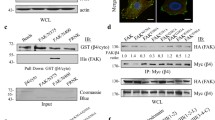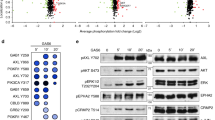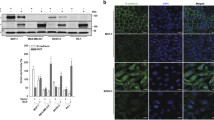Abstract
Expression of the glycosylphosphatidylinositol-anchored membrane protein CD24 correlates with a poor prognosis for many human cancers, and in experimental tumors can promote metastasis. However, the mechanism by which CD24 contributes to tumor progression remains unclear. Here we report that in MTLy breast cancer cells CD24 interacts with and augments the kinase activity of c-src, a protein strongly implicated in promoting invasion and metastasis. This occurs within and is dependent upon intact lipid rafts. CD24-augmented c-src kinase activity increased formation of focal adhesion complexes, accelerated phosphorylation of FAK and paxillin and consequently enhanced integrin-mediated adhesion. Loss and gain of function approaches showed that c-src activity is necessary and sufficient to mediate the effects of CD24 on integrin-dependent adhesion and cell spreading, as well as on invasion. Together these results indicate that c-src is a CD24-activated mediator that promotes integrin-mediated adhesion and invasion, and suggest a mechanism by which CD24 might contribute to tumor progression through stimulating the activity of c-src or another member of the Src family.








Similar content being viewed by others
References
Henniker AJ (2001) Cd24. J Biol Regul Homeost Agents 15:182–184
Aigner S, Ramos CL, Hafezi-Moghadam A, Lawrence MB, Friederichs J, Altevogt P, Ley K (1998) CD24 mediates rolling of breast carcinoma cells on P-selectin. FASEB J 12:1241–1251
Kadmon G, Imhof BA, Altevogt P, Schachner M (1995) Adhesive hierarchy involving the cell adhesion molecules L1, CD24, and alpha 6 integrin in murine neuroblastoma N2A cells. Biochem Biophys Res Commun 214:94–101
Sammar M, Aigner S, Altevogt P (1997) Heat-stable antigen (mouse CD24) in the brain: dual but distinct interaction with P-selectin and L1. Biochim Biophys Acta 1337:287–294
Nielsen PJ, Lorenz B, Muller AM, Wenger RH, Brombacher F, Simon M, von der Weid T, Langhorne WJ, Mossmann H, Kohler G (1997) Altered erythrocytes and a leaky block in B-cell development in CD24/HSA-deficient mice. Blood 89:1058–1067
Kadmon G, von Bohlen und Halbach F, Schachner M, Altevogt P (1994) Differential, LFA-1-sensitive effects of antibodies to nectadrin, the heat-stable antigen, on B lymphoblast aggregation and signal transduction. Biochem Biophys Res Commun 198:1209–1215
Belvindrah R, Rougon G, Chazal G (2002) Increased neurogenesis in adult mCD24-deficient mice. J Neurosci 22:3594–3607
Shewan D, Calaora V, Nielsen P, Cohen J, Rougon G, Moreau H (1996) mCD24, a glycoprotein transiently expressed by neurons, is an inhibitor of neurite outgrowth. J Neurosci 16:2624–2634
Kleene R, Yang H, Kutsche M, Schachner M (2001) The neural recognition molecule L1 is a sialic acid-binding lectin for CD24, which induces promotion and inhibition of neurite outgrowth. J Biol Chem 276:21656–21663
Cremers N, Deugnier MA, Sleeman J (2010) Loss of CD24 expression promotes ductal branching in the murine mammary gland. Cell Mol Life Sci 67:2311–2322
Kristiansen G, Sammar M, Altevogt P (2004) Tumour biological aspects of CD24, a mucin-like adhesion molecule. J Mol Histol 35:255–262
Yang GP, Ross DT, Kuang WW, Brown PO, Weigel RJ (1999) Combining SSH and cDNA microarrays for rapid identification of differentially expressed genes. Nucleic Acids Res 27:1517–1523
Nestl A, Von Stein OD, Zatloukal K, Thies WG, Herrlich P, Hofmann M, Sleeman JP (2001) Gene expression patterns associated with the metastatic phenotype in rodent and human tumors. Cancer Res 61:1569–1577
Pedersen MW, Thykjaer T, Orntoft TF, Damstrup L, Poulsen HS (2001) Profile of differentially expressed genes mediated by the type III epidermal growth factor receptor mutation expressed in a small-cell lung cancer cell line. Br J Cancer 85:1211–1218
Boon K, Edwards JB, Siu IM, Olschner D, Eberhart CG, Marra MA, Strausberg RL, Riggins GJ (2003) Comparison of medulloblastoma and normal neural transcriptomes identifies a restricted set of activated genes. Oncogene 22:7687–7694
Kohlgraf KG, Gawron AJ, Higashi M, Meza JL, Burdick MD, Kitajima S, Kelly DL, Caffrey TC, Hollingsworth MA (2003) Contribution of the MUC1 tandem repeat and cytoplasmic tail to invasive and metastatic properties of a pancreatic cancer cell line. Cancer Res 63:5011–5020
Sleeman JP, Cremers N (2007) New concepts in breast cancer metastasis: tumor initiating cells and the microenvironment. Clin Exp Metastasis 24:707–715
Senner V, Sturm A, Baur I, Schrell UH, Distel L, Paulus W (1999) CD24 promotes invasion of glioma cells in vivo. J Neuropathol Exp Neurol 58:795–802
Schabath H, Runz S, Joumaa S, Altevogt P (2006) CD24 affects CXCR4 function in pre-B lymphocytes and breast carcinoma cells. J Cell Sci 119:314–325
Baumann P, Cremers N, Kroese F, Orend G, Chiquet-Ehrismann R, Uede T, Yagita H, Sleeman JP (2005) CD24 expression causes the acquisition of multiple cellular properties associated with tumor growth and metastasis. Cancer Res 65:10783–10793
Brunton VG, Frame MC (2008) Src and focal adhesion kinase as therapeutic targets in cancer. Curr Opin Pharmacol 8:427–432
Alvarez RH, Kantarjian HM, Cortes JE (2006) The role of Src in solid and hematologic malignancies: development of new-generation Src inhibitors. Cancer 107:1918–1929
Timpson P, Jones GE, Frame MC, Brunton VG (2001) Coordination of cell polarization and migration by the Rho family GTPases requires Src tyrosine kinase activity. Curr Biol 11:1836–1846
Paulick MG, Bertozzi CR (2008) The glycosylphosphatidylinositol anchor: a complex membrane-anchoring structure for proteins. Biochemistry 47:6991–7000
Runz S, Mierke CT, Joumaa S, Behrens J, Fabry B, Altevogt P (2008) CD24 induces localization of beta1 integrin to lipid raft domains. Biochem Biophys Res Commun 365:35–41
Keller P, Simons K (1998) Cholesterol is required for surface transport of influenza virus hemagglutinin. J Cell Biol 140:1357–1367
Kilsdonk EP, Yancey PG, Stoudt GW, Bangerter FW, Johnson WJ, Phillips MC, Rothblat GH (1995) Cellular cholesterol efflux mediated by cyclodextrins. J Biol Chem 270:17250–17256
Scheiffele P, Roth MG, Simons K (1997) Interaction of influenza virus haemagglutinin with sphingolipid-cholesterol membrane domains via its transmembrane domain. EMBO J 16:5501–5508
Zarn JA, Zimmermann SM, Pass MK, Waibel R, Stahel RA (1996) Association of CD24 with the kinase c-fgr in a small cell lung cancer cell line and with the kinase lyn in an erythroleukemia cell line. Biochem Biophys Res Commun 225:384–391
Sammar M, Gulbins E, Hilbert K, Lang F, Altevogt P (1997) Mouse CD24 as a signaling molecule for integrin-mediated cell binding: functional and physical association with src-kinases. Biochem Biophys Res Commun 234:330–334
Lingwood D, Simons K (2010) Lipid rafts as a membrane-organising principle. Science 327:46–50
Simons K, Toomre D (2000) Lipid rafts and signal transduction. Nat Rev Mol Cell Biol 1:31–39
Narisawa-Saito M, Yamanashi Y, Morioka T, Oite T, Shimizu F (1996) Thy-1 molecule associates with protein tyrosine kinase(s) in rat mesangial cells. Clin Exp Immunol 106:86–90
Rege TA, Pallero MA, Gomez C, Grenett HE, Murphy-Ullrich JE, Hagood JS (2006) Thy-1, via its GPI anchor, modulates Src family kinase and focal adhesion kinase phosphorylation and subcellular localization, and fibroblast migration, in response to thrombospondin-1/hep I. Exp Cell Res 312:3752–3767
Kramer EM, Klein C, Koch T, Boytinck M, Trotter J (1999) Compartmentation of Fyn kinase with glycosylphosphatidylinositol-anchored molecules in oligodendrocytes facilitates kinase activation during myelination. J Biol Chem 274:29042–29049
Kasahara K, Watanabe K, Takeuchi K, Kaneko H, Oohira A, Yamamoto T, Sanai Y (2000) Involvement of gangliosides in glycosylphosphatidylinositol-anchored neuronal cell adhesion molecule TAG-1 signaling in lipid rafts. J Biol Chem 275:34701–34709
Suzuki T, Kiyokawa N, Taguchi T, Sekino T, Katagiri YU, Fujimoto J (2001) CD24 induces apoptosis in human B cells via the glycolipid-enriched membrane domains/rafts-mediated signaling system. J Immunol 166:5567–5577
Suzuki KG, Fujiwara TK, Sanematsu F, Iino R, Edidin M, Kusumi A (2007) GPI-anchored receptor clusters transiently recruit Lyn and G alpha for temporary cluster immobilization and Lyn activation: single-molecule tracking study 1. J Cell Biol 177:717–730
Lu S, Ouyang M, Seong J, Zhang J, Chien S, Wang Y (2008) The spatiotemporal pattern of Src activation at lipid rafts revealed by diffusion-corrected FRET imaging. PLoS Comput Biol 4:e1000127
Young RM, Holowka D, Baird B (2003) A lipid raft environment enhances Lyn kinase activity by protecting the active site tyrosine from dephosphorylation. J Biol Chem 278:20746–20752
Oneyama C, Hikita T, Enya K, Dobenecker MW, Saito K, Nada S, Tarakhovsky A, Okada M (2008) The lipid raft-anchored adaptor protein Cbp controls the oncogenic potential of c-Src. Mol Cell 30:426–436
Williams NK, Lucet IS, Klinken SP, Ingley E, Rossjohn J (2009) Crystal structures of the Lyn protein tyrosine kinase domain in its Apo- and inhibitor-bound state. J Biol Chem 284:284–291
Harris KF, Shoji I, Cooper EM, Kumar S, Oda H, Howley PM (1999) Ubiquitin-mediated degradation of active Src tyrosine kinase. Proc Natl Acad Sci U S A 96:13738–13743
Hitosugi T, Sato M, Sasaki K, Umezawa Y (2007) Lipid raft specific knockdown of SRC family kinase activity inhibits cell adhesion and cell cycle progression of breast cancer cells. Cancer Res 67:8139–8148
Zhang XH, Wang Q, Gerald W, Hudis CA, Norton L, Smid M, Foekens JA, Massague J (2009) Latent bone metastasis in breast cancer tied to Src-dependent survival signals. Cancer Cell 16:67–78
Ishizawar R, Parsons SJ (2004) c-Src and cooperating partners in human cancer. Cancer Cell 6:209–214
Sagiv E, Starr A, Rozovski U, Khosravi R, Altevogt P, Wang T, Arber N (2008) Targeting CD24 for treatment of colorectal and pancreatic cancer by monoclonal antibodies or small interfering RNA. Cancer Res 68:2803–2812
Kim LC, Song L, Haura EB (2009) Src kinases as therapeutic targets for cancer. Nat Rev Clin Oncol 6:587–595
Acknowledgments
This work was supported by grants to J.P.S. from the European Union (FP6 STREP project BRECOSM, contract no. LSHC-CT-2004-503224, and FP7 Collaborative Project TuMIC, contract no. HEALTH-F2-2008-201662).
Author information
Authors and Affiliations
Corresponding author
Electronic supplementary material
Below is the link to the electronic supplementary material.
18_2011_756_MOESM1_ESM.tif
Expression of CD24 is not altered after treatment with MCD. MTLy cells were incubated with and without MCD for 5 min, then immunostained with anti-CD24 antibodies and fluorescent secondary antibodies as described in Materials and methods (TIFF 173 kb)
18_2011_756_MOESM2_ESM.tif
Expression of β1 integrin after CD24 expression. MTLyCD24ind cells were induced (+ Dox) and not induced (− Dox) to express CD24. Cells were then stained with HUTS, an antibody that recognizes an epitope on active β1 integrin subunits, with an anti-β1 integrin antibody that recognizes all β1 integrin conformations, and with antibodies against CD24. Plots of fluorescence intensity (abscissa, log scale) against cell number (ordinate, linear scale) are presented filled trace background fluorescence, open trace staining with the respective antibody).Supplementary material 2 (TIFF 165 kb)
Rights and permissions
About this article
Cite this article
Baumann, P., Thiele, W., Cremers, N. et al. CD24 interacts with and promotes the activity of c-src within lipid rafts in breast cancer cells, thereby increasing integrin-dependent adhesion. Cell. Mol. Life Sci. 69, 435–448 (2012). https://doi.org/10.1007/s00018-011-0756-9
Received:
Revised:
Accepted:
Published:
Issue Date:
DOI: https://doi.org/10.1007/s00018-011-0756-9




